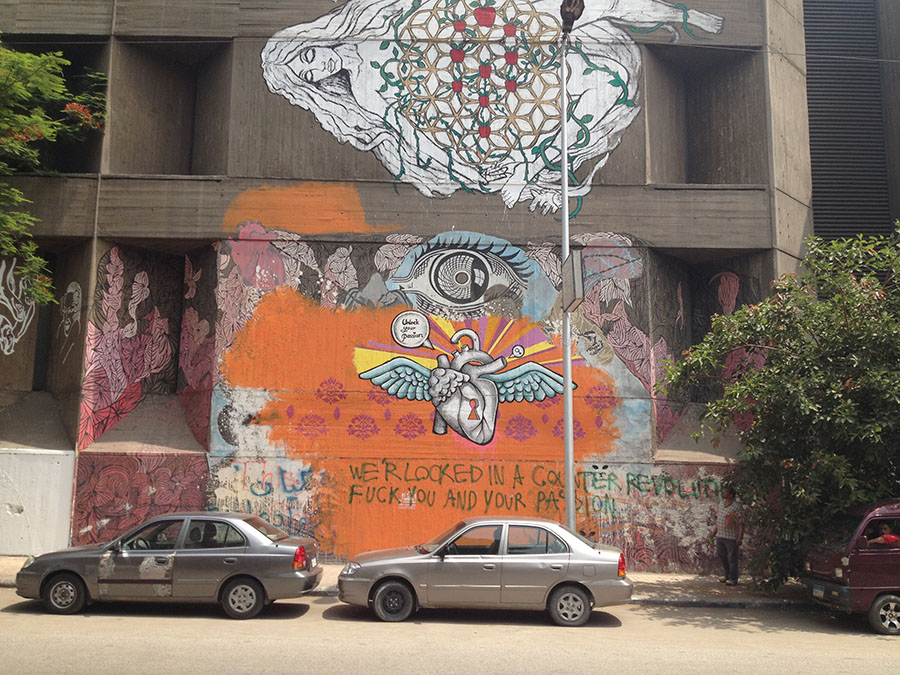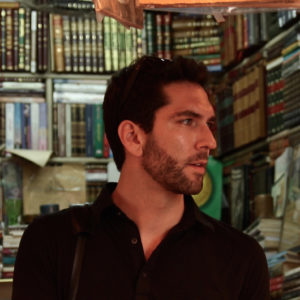Based in Cairo, I am examining media and visual culture in Egypt and across the Middle East. I have researched comics and satire in the region since 2012. Spending long evenings with cartoonists grappling with the aftermath of the revolution, I discovered that pop culture captures significant and subversive narratives that are often absent from the Western media’s coverage of the Middle East. Indeed the mainstream media often paints the Middle East as violent and backward, focusing on terrorism and security. My goal, as an ICWA fellow, is to offer more complicated and comprehensive stories. I want share with the world the films, paintings, music, and other cultural productions that will shape the future of the Middle East.
CAIRO, Egypt–They paved Tahrir and put up a parking garage.
In the four years that have passed since the uprising that toppled Egypt’s autocrat Hosni Mubarak, Midan Tahrir—Liberation Square—has been transformed from a site of protest to no-man’s land. Public demonstrations are effectively forbidden, so Egyptians have taken to other arenas. Some are focusing on investment and entrepreneurship. Others are experimenting in the aesthetic realm; new works, including cinema and comics, deliberate over the arrested revolution.
During the 18 days of the January 2011 revolution, Tahrir Square accommodated a cacophony of voices. Thousands of protesters camped in Cairo’s focal point. The urban space connects dozens of downtown neighborhoods, each with its own characters, buildings and stories. In the daytime, millions of demonstrators parked themselves in the middle of it all. In defiance of the police, they created a small village in the 45,000 square meters of the traffic circle. The faded graffiti commemorating slain protesters and the old protest slogans emblazoned on downtown walls are the only reminders that Tahrir Square was once the heart of a revolution.
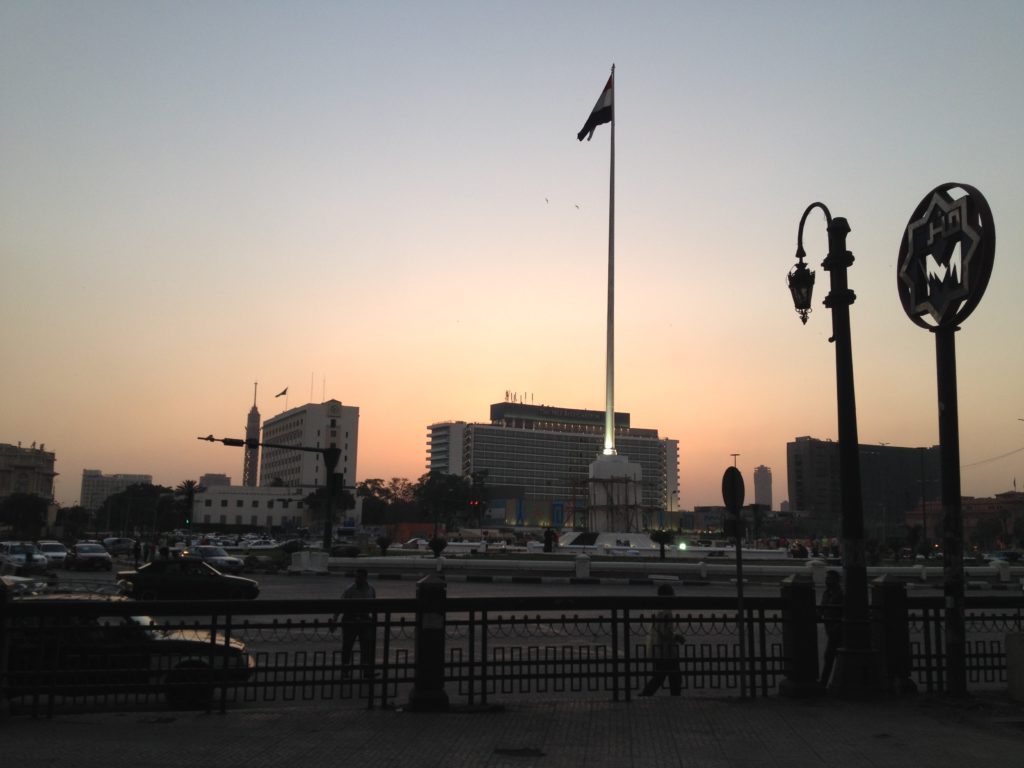
On the fourth anniversary of the uprising, in January 2015, Prime Minister Ibrahim Mehleb inaugurated a giant underground parking garage immediately west of Tahrir, situated between the pink halls of the Egyptian Museum and the stately gates of the Arab League’s headquarters. The government launched the project about a decade before the uprising. Given the glacial pace of Egyptian state bureaucracy, it took over 15 years to complete the structure. (The mammoth Aswan Dam, by contrast, took 16 years.) Now, four subterranean levels can accommodate 1,700 cars and 24 tourist buses in a structure that cost 675 million Egyptian pounds (about US$89 million). Equally important, completing the garage project in Tahrir Square also signals that the government is marching on, as if there never were an uprising at all.
The Tahrir Garage exemplifies the mismanagement of Cairo’s urban spaces, where top-down policy prescriptions prevail over consideration of people’s needs. Traffic plagues this megacity, which struggles to accommodate over 20 million inhabitants and 2 million registered cars. According to a 2014 study by the World Bank, “Approximately 47 billion LE, or 8 billion USD, are wasted every year in the Greater Cairo Metropolitan Area due to congestion.”[1] That amounts to 3.6 percent of Egypt’s total GDP. (Think about all of the time workers spend in standstill traffic, the wasted fuel, and the air pollution.) Adding an enormous garage in the city center does little to alleviate that problem. On a recent afternoon, digital signs informed passersby that there were 1300 vacant spaces in the garage.
At street level, the parking garage is but a bleak sprawl of concrete jungle—no green space, no benches, nothing practical. Black, newly painted Tahrir Garage traffic barricades are haphazardly placed on street corners throughout downtown. Many barricades contain typos in the Arabic spelling of “Garage.” Police have appropriated a plethora of these barriers for the ever-expanding network of security checkpoints. Painted on each barricade is an arrow intended to point toward the Tahrir Garage; half the time, the arrow points in the wrong direction.
In addition to the garage, the other major change is a 20-meter flagpole erected in Tahrir Square’s center. Flying an Egyptian flag high above the symbolic space implicitly raises the question of how a state can monumentalize a revolution that some dissenters say is dead and others say is ongoing. Given that a previous monument in Tahrir was defaced and vandalized several times by activists, the use of the Egyptian flag can be read as the lowest common denominator for a thorny political question. My friend, reporter Maggie Fick, phrased the dilemma this way: “how to honor the epicentre of the 2011 popular uprising while pressing ahead with one of the fiercest crackdowns on dissent in Egypt’s history?”[2]
From Revolution to Counter-Revolution
The extent of the crackdown is why the economic and artistic realms have emerged as platforms for discordant voices attempting to steer the country’s future. Before exploring how businessmen and artists are coping with the restrictions, it helps to remember how Egypt arrived at a point where such extreme measures were not only deemed necessary, but widely embraced.
In July 2013, then General Abdel-Fattah El-Sisi overthrew Egypt’s first democratically-elected president, Mohammed Morsi, a senior Muslim Brotherhood leader. Hundreds of thousands gathered in Tahrir Square to support the power play, giving Defense Minister El-Sisi the opportunity to paint Morsi’s downfall as the country’s second popular uprising in four years. The local press, mostly secular and staunchly anti-Islamist, gleefully parroted the narrative. Denying that the maneuver was a coup, key media elites insisted that Morsi’s ouster was an expression of the people’s will. In this version of events, June 30, 2013—the day nation-wide demonstrations against Morsi started—was the continuation of the January 25, 2011, uprising.
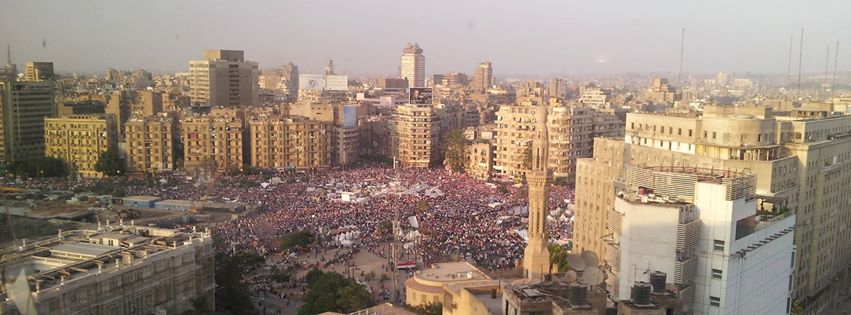
What has ensued is a broad assault on human rights that has enjoyed widespread popular and media support. Security forces launched lethal attacks on pro-Morsi encampments in northeastern and western Cairo, culminating in a massacre of over a thousand protesters in August 2013. Human Rights Watch called the killings, “likely crimes against humanity.” Then, in November of that year, the interim government passed a law that essentially banned marches, rallies, and sit-ins. All public gatherings of more than ten people require a permit from the state, which have been difficult to come by. Since then, Tahrir has remained bereft of public protest.
The crackdown on journalists has been equally troubling. The most notorious case has been of the “Marriott Cell,” the three-man Al Jazeera English team that was operating out of the Marriott Hotel and arrested on December 29, 2013. They were charged with membership in a terrorist group, abetting a terror group, broadcasting false news, and operating without a permit. While the final point can be disputed (and, if true, reflects Al Jazeera’s negligence of its staff), the other accusations are baseless. The whole case results from Al Jazeera’s intimate ties to the Qatari government, the Muslim Brotherhood’s primary benefactor, and Al Jazeera’s on-air support for Morsi. A high-profile show trial became an opportunity for the Egyptian government to shame Qatar for its meddling in Egyptian affairs. Pawns in the game, Mohammed Fadel Fahmy, Baher Mohammed and Peter Greste were placed in a cage for dozens of sessions. Fahmy, the bureau chief who had previously reported extensively for CNN, and his colleagues sat in the notorious Tora Prison for over a year. Ultimately, the three were convicted and sentenced to seven-to-ten years in prison.
In December, the country’s top appeals court found insufficient evidence in the previous proceedings and ordered for a retrial, which is underway. Fahmy was released on bail, as he awaits the new ruling. At a popular French journalist’s recent farewell party, Fahmy and his wife stood at the corner of the dance floor, on the terrace of the elite Garden City Club, as Europop blared. Expat journalists who had attended the series of court hearings approached Fahmy to shake his hand. It was a great relief for all to see him in a brightly patterned button-down shirt instead of the prison whites he had worn for the initial trial.
The state has suppressed the country’s most organized and popular opposition movements. In December 2013, the Muslim Brotherhood was declared a “terrorist group,” outlawing its activities. The crackdown has extended to non-Islamists, too. Last year, a court banned the April 6 Youth Movement, a secular grassroots group that helped catalyze the 2011 revolt. Recently, a court banned popular soccer fan groups, known as Ultras, dubbing the soccer hooligans, “terrorists.” (As with unruly soccer fans in Europe, surely these are a violent bunch, but it’s a stretch to label them terrorists.)
El-Sisi continues to consolidate his power with the assistance of activist judges, and without a functioning legislative branch to hold the military strongman in check. Egypt has lacked a parliament since June 2012, when a court dissolved the Muslim Brotherhood-dominated people’s assembly on the eve of Morsi’s inauguration. The balloting was scheduled for some time this spring, though now it has been pushed off to an unknown date in the future. All of this impairs the conditions for holding free and fair elections, which have been repeatedly postponed.
Anwar, a young cartoonist for the popular privately-owned daily Al-Masry Al-Youm, illustrated his own fatigue with ongoing political machinations: two skeletons sit on a street café; one reads the newspaper, one’s hands sit in his lap. It is titled: “Waiting for the Parliament.”
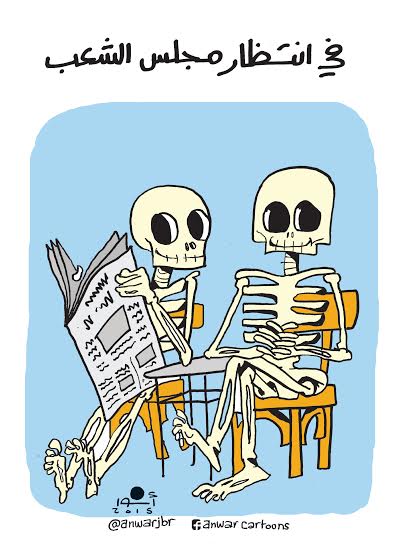
Taken together, these developments constitute “concrete steps to quash dissent, silence opposition voices, and consolidate control over the body politic,” writes independent journalist Sharif Abdel Kouddous. The veteran Cairo-based reporter draws parallels to George Orwell’s 1984.[3] (That book is on sale in Arabic translation at nearly every corner newsstand in the capital.) Literally and figuratively, the space for dissent is more limited than any time in recent memory.
It is all quite a change from when I moved to Cairo, in 2012. The city then was saturated with public protest—political debates at juice stands and street corners, political posters on every single city wall alongside graffiti, both angry and whimsical. Today, Tahrir is no longer a safety valve. It is no longer a location for popular dissent. The square’s ad-hoc cafes and souvenir stands are long gone, though in the evening scores of people sit on the curb or the square’s metal gates anyway, just hanging out. The street sellers have been pushed out of the city center. Dozens of police and military personnel ensure that the traffic is constantly moving, albeit at a snail’s pace due to congestion.
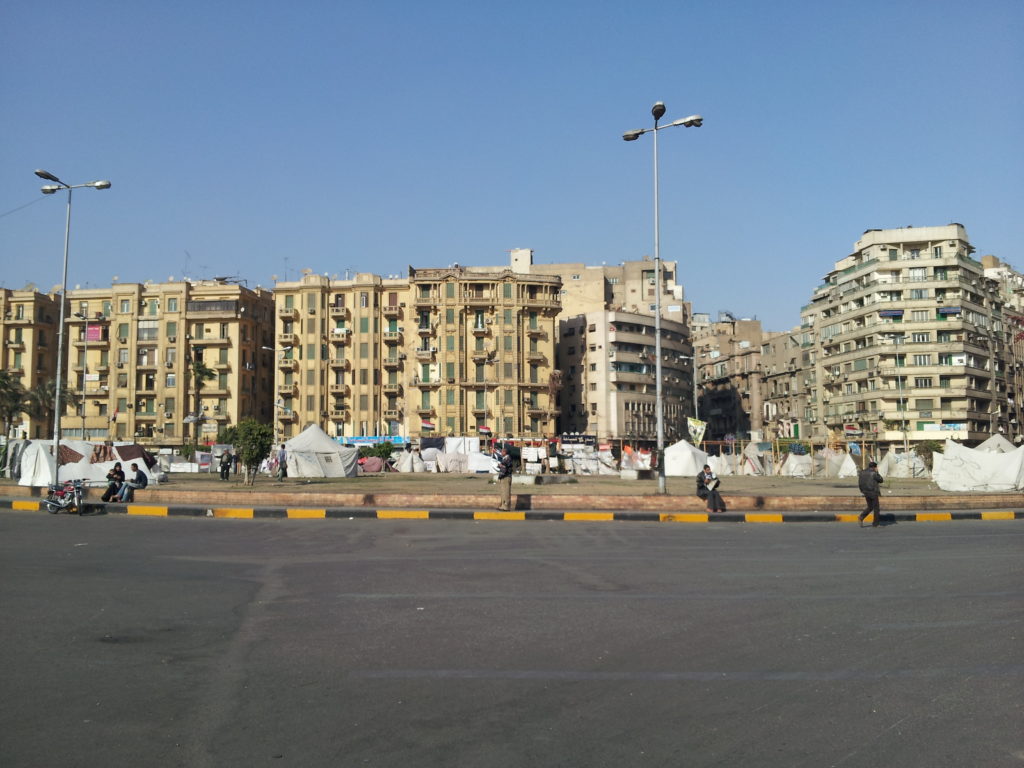
One day this spring, the vintage buildings circling Tahrir were freshly repainted, the shutters of French windows are coated in a rich green. Scaffolding in Talaat Harb Square, the major intersection north of Tahrir, suggested that downtown’s historic quarters were all receiving cosmetic makeovers. In the surrounding blocks, however, dilapidated buildings remain untouched. Around the corner from the square, the former headquarters of Mubarak’s National Democratic Party, which was torched during the 18 days of revolution, had a new banner covering the building’s burnt out frame. “Adaptive reuse would have been the obvious solution for the tower block but this was never considered by authorities,” writes urbanist Mohamed Elshahed on his indispensible blog, Cairobserver, where he and others analyze the city and its architecture. The NDP building is now being demolished as city planners attempt to erase the past.
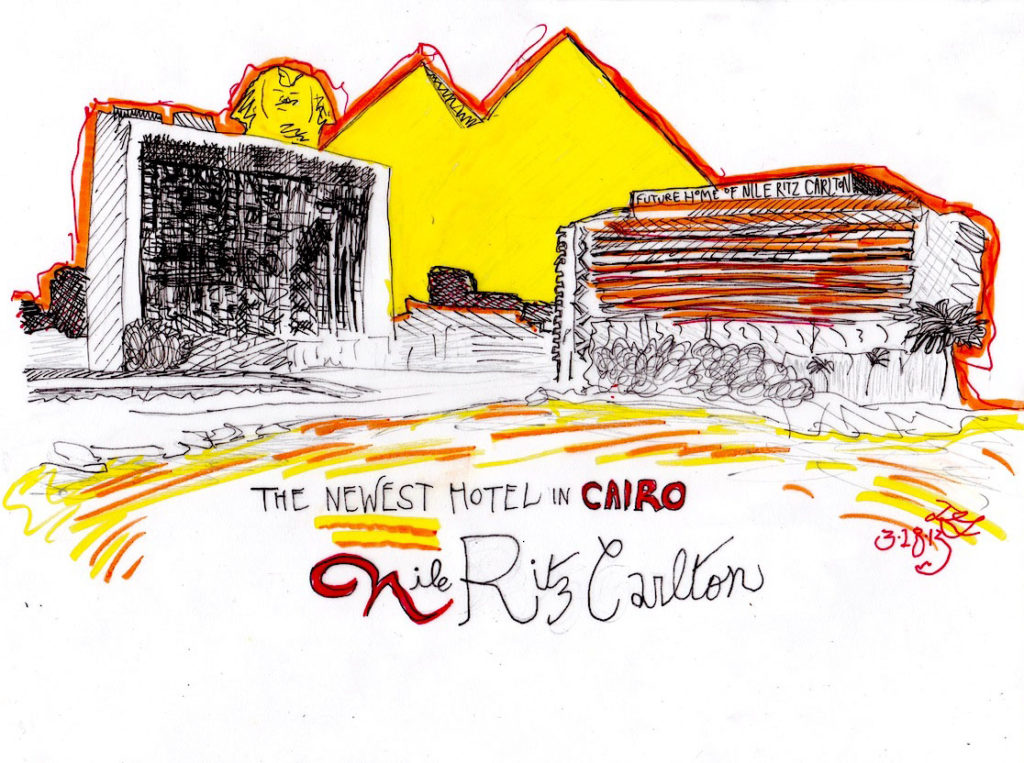
The Ritz Carlton has overhauled the iconic Nile Hilton, closed since 2009, which is set to reopen at the end of July. The governorate has placed traffic lights in many of downtown’s busiest roads, though drivers tend to ignore those signals unless a policeman enforces them. The superficiality of these developments—grand in scale, modest in impact—highlights the government’s emphasis on mega-projects that do little to support the average Cairene.
Tahrir’s makeover has come just as the government has sought to crush the very liberation that the square symbolized. President El-Sisi can take credit for establishing a semblance of stability in downtown Cairo. Indeed, it is a treat to see the facades of prominent 19th century buildings restored to their original glory. But vast underlying problems—pervasive unemployment and corruption, to name a few—endure. And the burgeoning police state has not prevented insurgents from planting amateur explosives. (Local news reports often cover police defusing small bombs prior to detonation, though few of these stories make it to the Western press.) The sporadic terror attacks, mostly targeting the government and military, suggest that a drawn out urban insurrection has begun.
The Coolest Place to Work in the Arab World
Ahmed El Alfi wants to make downtown Cairo “the coolest, most fun place to work in the Arab world.” In 2013, he launched a high-tech office park on Mohammed Mahmoud Street, the site of a series of deadly clashes that started in 2011, which is a five-minute walk from Tahrir Square.
Alfi has leased a 269,000 square-foot self-enclosed campus from the American University in Cairo (AUC). In 2008, the university left its historic location, where it had been operating since 1919, and moved classes and offices to the Fifth Settlement, in New Cairo, about 20 miles out of the city and into the desert. In Cairo’s heavy traffic, that journey can take up to two hours. The trend of the wealthy fleeing city center to far-flung gated communities is changing the makeup of Cairo, a shift that has been going on for decades. But the departure of Egypt’s most prestigious academic institution emblemizes downtown’s decline. Notwithstanding the revitalization of a few key buildings, the city center mostly consists of B- and C-grade shops; big name brands are in Western-style malls located faraway in satellite cities. The cosmopolitan history of Cairo is embedded in its dilapidating buildings, where long-term residential tenants tend to pay rents of only 50 cents a month for prime real estate thanks to antiquated property laws.
Investors like structure and predictability, notes Alfi, who likens the city to “a dysfunctional video game,” where the rules of the game are inconsistently applied. I was surprised to hear a venture capitalist—a private sector enthusiast—craving more government intervention downtown. “Any implementation of regs and systemization is an uptick for downtown,” he says. “You can’t get to over-regulation from where we are today.”
Alfi’s mission is to create a central “innovation park” for start-ups and established companies to tap into young talent. The property was long known as AUC’s Greek Campus, and has been renamed the GrEEK Campus, with an emphasis on the geeky tech work being done there. Currently at half-occupancy, about a thousand people work there at everything from Uber to digital app development businesses, as well as firms specializing in e-commerce, handicrafts, catering, event planning, real estate, and more, totaling about 100 start-ups.
Alfi’s outdoor desk looks out onto the massive courtyard, decorated with sculptures and greenery, wicker chairs sitting under the shadows of large trees. When I turn on my tape recorder, Alfi tells me that he won’t talk politics on-the-record, which speaks volumes.
“I couldn’t live in Cairo and not see the Nile every day,” says Alfi, wearing a suit, silk tie and cuff links. “I didn’t leave the suburbs of southern California to come to the suburbs of Cairo. I came here to be in the middle of the dynamic city this is. This is the place.” He previously served as CEO of EFG Hermes, Egypt’s most powerful private equity firm, and a co-founder of Flat Six Labs, a start-up incubator that then Secretary of State Hillary Clinton visited in August 2012 when visiting Cairo.
“I’m not into the symbolism of Tahrir Square. That’s not part of the agenda here at all,” says Alfi. He is into the accessibility of Tahrir Square. By his estimate, between 25 and 30 million people can reach the city center in about an hour, “which makes it one of the most accessible points on earth for the largest number of people,” he says. “People want to come here for reasons that are so different from politics—I shouldn’t say that it transcends the importance, it’s separate and apart from politics.”
For many Cairenes, however, it is impossible to separate this particular space from its political significance. In November 2011, Mohammed Mahmoud Street, the one-way artery that leads from Tahrir Square to the campus, was the site of pitched street battles between the police and protesters for five days that left almost 50 dead. Those horrifying videos on CNN of protesters losing eyes, of buildings and tires burning, of teargas and birdshot flying back and forth—were shot on Mohammed Mahmoud Street. Parts of the sidewalk are still torn up from the barricades that protesters built with the concrete. Many of the small businesses on the street are still shuttered.
An Egyptian-American investor who lives and owns property on Mohammed Mahmoud Street (and who prefers not to be named), remembers those as the darkest days of the city: “A lot of people got killed here. A lot of traumatic experiences. It was just dusty and the country was in a state of despair, and there was a sense of hopelessness and erosion that made no sense in such a prime place in 2012.” As for the graffiti, “I want it gone,” he says, emphasizing how it is a reminder of “the low point of the trough of the kind of political dysfunction.”
The graffiti of Mohammed Mahmoud Street endures, covering the gates of the university and the GrEEK campus, and just about every piece of brick and mortar in the vicinity. The street art offers a living museum of the revolution’s ephemera. It captures the gut reactions of the people to the ongoing struggles for freedom. There are scores of memorials to young martyrs of the revolution, jokes mocking authority, re-appropriated political cartoons from the local press, and intricate neo-Pharaonic murals, alongside crudely sprayed anarchist symbols and curse words.
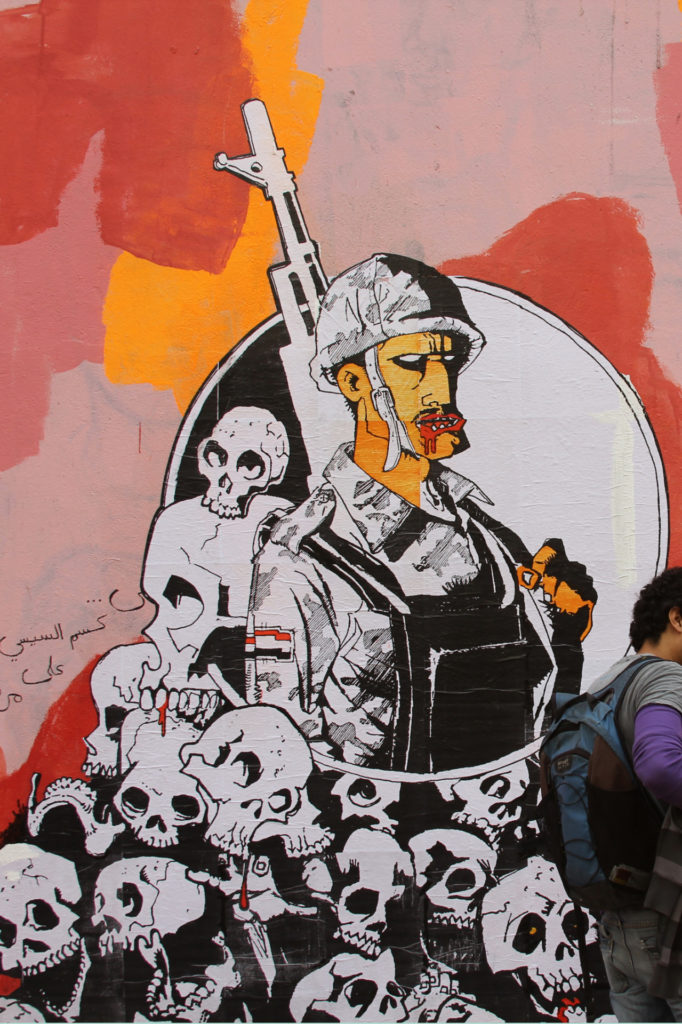
A paste-up by the graphic artist Ganzeer has remained upon the AUC’s gates for two years. In it, a mustachioed soldier, wearing a hard hat with a rifle slung over his soldier, stands over a pile of skulls. “The Army Above All Else,” the Arabic caption below it reads, a riff off the popular 2011 slogan, “Egypt Above All Else.” Ganzeer, a harsh critic of both the Muslim Brotherhood and the military, departed from Egypt in April 2014 after a jingoistic television host aired his real name on air and falsely called him a Brotherhood supporter. Ganzeer is now based in the U.S. and staunchly critical of the El-Sisi government. Though he is now producing art for major galleries in New York, the violent and powerful imagery on the downtown walls cannot be erased. “It’s nice to know that this piece is still up,” Ganzeer posted on Facebook last week.
Alfi is less than excited about the graffiti on his tech campus’s outer walls, which he calls, “depressing stuff… negativist, dark, gloomy.” He decided to paint over some of it. “The stuff here, the bottom three meters: I whitewashed it, the revolutionary shit,” he says, because “they were cussing.” In fact, he has tried to re-appropriate the art form. Seeking “a topical expression of art instead of a memorial,” he commissioned the Women on Walls initiative, a group of local artists, to paint graffiti with positive messages. The paintings are several meters above street level so that taggers cannot muck up the aesthetic. A heart with light blue wings, a keyhole in its center, flies incongruously on a bright orange backdrop on one section of the wall; the muscular organ says, “Unlock Your Passion.” Below it, someone sloppily wrote in green spray paint: “WE’RE LOCKED IN A COUNTER-REVOLUTION: FUCK YOU AND YOUR PASSION.” It seems that even a prominent venture capitalist cannot control the graffiti on the walls of his building.
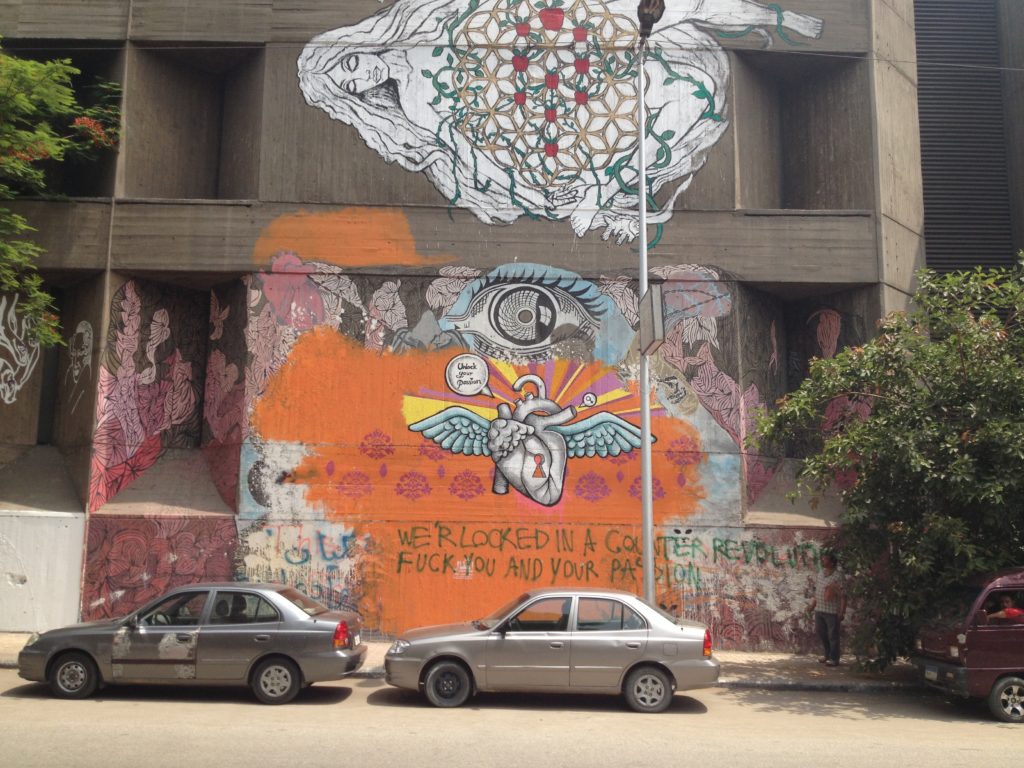
The most famous slogan of the 2011 uprising was “Bread, Freedom and Social Justice,” and the El-Sisi government is focusing on the “bread” part of the equation. But success will prove difficult given the country’s economic downtown and rapid inflation of the past four years. Yet investors like Alfi are bullish about investing in downtown, even as the government lays plans to move its primary operations to a new capital at the city’s outskirts. The outlandish proposed plan, which is budgeted at a staggering $300 billion, was revealed at a high-profile economic summit in the Sinai beach town of Sharm El-Sheikh in March. Alfi quipped that the beautifying and repainting of downtown buildings was for the economic summit’s promotional videos. The government merely sought an attractive backdrop for its films in the hopes of attracting more investment.
Artists in the City
Beyond graffiti, Egyptian artists are taking radical approaches to urban spaces. In the city center, long a hub for art galleries and collectives, several new creative communities have launched and expanded their activities despite the clampdown on other forms of expression. Zawya, Cairo’s first art house cinema, opened in 2014, and another independent film collective and theater, Cimateque, launched this month. The Nile Sunset Annex, a project run by three local artists, hosts regular shows in an apartment in Garden City, a ten-minute walk from Tahrir Square. More established contemporary art galleries like Mashrabia and Townhouse, both operating downtown for over 15 years, continue to exhibit subversive shows in which artists are sifting through the recent past and pushing ahead toward the future.
Meanwhile, commercialism is seeping into the art scene here, and Townhouse has opened Townhouse West, an upmarket gallery about an hour’s drive from downtown. (I have not had time to make it out there yet.) The intended audience for the new outlet must be the rich and famous living in Cairo’s ever-expanding ring of suburbs. Yet Huda Lutfi—the prominent visual artist whose exhibition “Magnetic Bodies,” inaugurated the new gallery—is a resident of downtown.
Lutfi joined the recent lecture and screening of the young Egyptian filmmaker Mohammad Shawky Hassan, who showed his works at Oriental Hall, a grand arabesque lecture room at the American University in Cairo’s downtown campus. Director of the Center for Translation Studies Samia Mehrez chaired the event. She dedicated the proceedings to Emad Shahin, the AUC professor of public policy and political science who received a death sentence the week prior for “grand espionage,” in what were obviously spurious allegations. Indeed, Shahin has been a prolific dissident, authoring numerous high-profile op-eds lambasting military rule. Above all, though, he is a prominent academic, having edited The Oxford Encyclopedia of Islam and Politics and regularly appearing in Washington’s think tank scene. Shahin had left for the U.S. last year, and has since been tried in absentia. The judge delivered the harshest sentence.
“We hope that this horrific sentence will be overturned in due time,” Mehrez said. The university itself had yet to make an official statement about the case. Whether the university’s silence signified an act of over-cautiousness or a subtle distancing of itself from Shahin, the very clear message has been one of callousness and a lack of solidarity.
Mohammad Shawky Hassan, in cargo shorts and a button-down, delivered poetic, prepared remarks introducing his three short films. His most recent, the 24-minute “And on a Different Note,” screened at the prestigious Berlinale this February. In the film, the silent protagonist walks aimlessly through a sparse New York apartment as well as a grocery store and other mundane scenes; toward the end, he peers out from windows onto roofs in Cairo. The film’s momentum comes from the soundtrack, where Egyptian talk-show hosts spew propaganda and strong nationalist words in high-pitched voices that characterize the very shrill discourses on local television and radio. Using experimental subtitling techniques, Shawky does not literally translate the stream of talk-show banter, and instead only selectively and creatively interprets bits of the conversation. In the English text at the bottom of the screen, Shawky has purposely left out words, chopped up sentences, or presented the copy in unconventional modes (at times a quick ticker in the style of CNN, or a conversation via text messages, or randomly spaced out words), forcing the viewer to fill in the blanks.
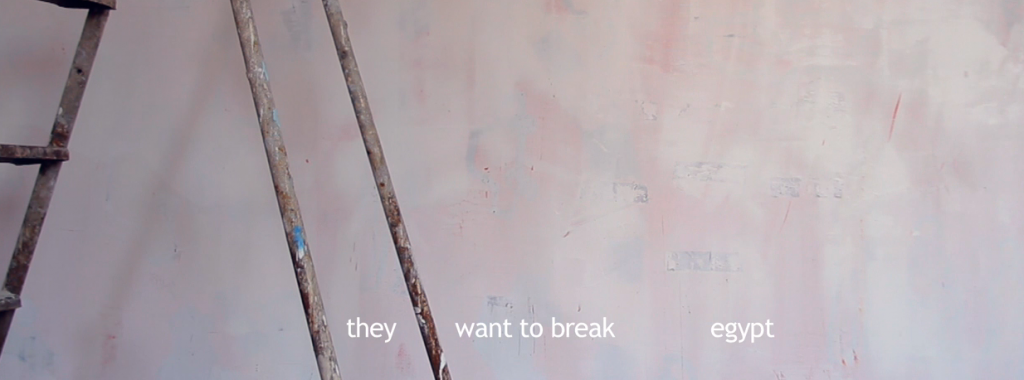
The product smacks of dark humor and conveys a sense of alienation and distance. In one scene, the protagonist sits in a New York laundromat, listening to an Egyptian pundit discussing El-Sisi. The dissonance jars the audience while pushing it toward laughter, in large part because the sometimes scant subtitles insufficiently translate the breathless shrieks of the Egyptian equivalent of Rush Limbaugh. “And on a Different Note” comments on the inability to translate the empty words of the Egyptian media all while challenging the linear, chronological narratives of the uprising. Despite all of the mass media attention focused on Egypt, Shawky’s film argues that much of the revolution and counter-revolution are untranslatable.
For Cairo’s illustrators, comics are another vehicle for conveying stories that are so often ignored by the mainstream media. In many comics, there is a new recognition of local spaces, local neighborhoods, places that are lived in, the sha’aby—the people’s—locales that have been previously brushed over. The rise of hyper-local illustrated narratives that have emerged since the 2011 uprising is not incidental. Former President Hosni Mubarak’s championed policies that privileged the construction of new cities over the restoring of the crumbling downtown. This means that the grand constructions of skyscrapers or the insensitive rehabilitation of decrepit structures were privileged; the struggling and poor neighborhoods of downtown left un-addressed. The current government’s plan to relocate Cairo’s capital represents another misguided approach to rehabilitating the city.
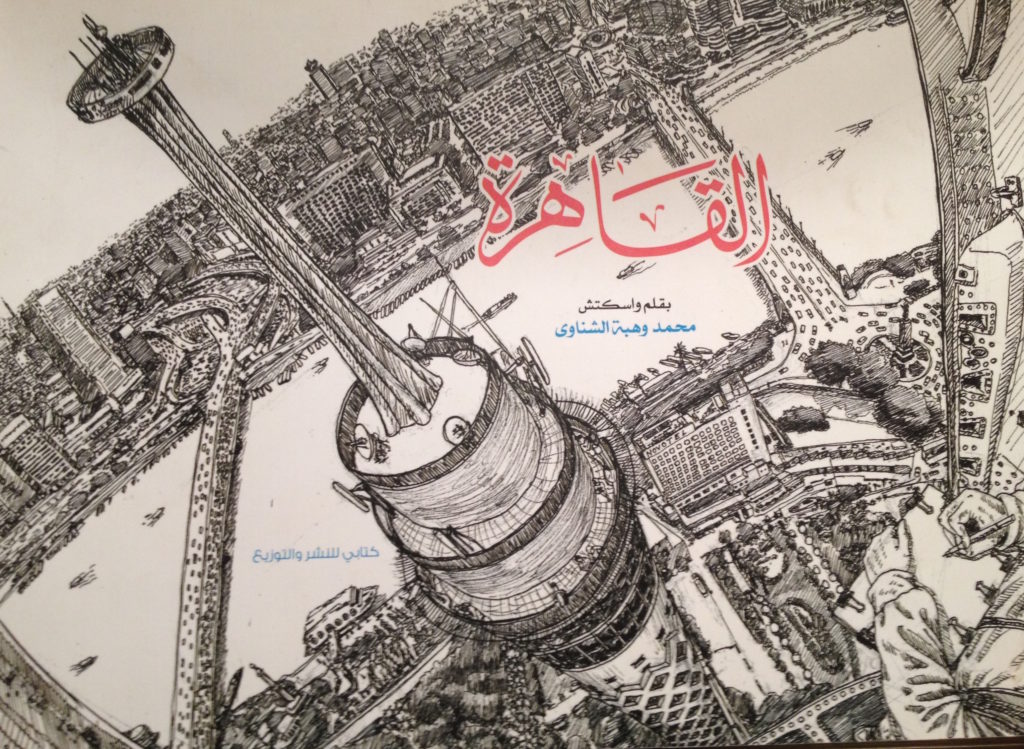
Those 18 days in Tahrir Square and the subsequent protests, art fairs, and others happenings downtown have led to a new awareness of the city itself. A prime example is a new book by the Egyptian comic artist Mohamed Wahba Elshenawy, entitled Cairo, which features over 50 intricate cityscapes of the bustling capital. Wahba’s illustrations are more vivid than photographs; in every stroke and shadow, his pen captures the mega-metropolis’s movement from great heights. Staring at the images leads to vertigo—my stomach churned while peering out at the Nile from atop the Cairo Tower, imagining that Wahba’s dangling legs were my own. It’s almost too real. He calls his technique, “nano-camera art.” The book is a mammoth accomplishment for a young artist’s first, and the cityscapes further emphasize the importance of Cairo’s complicated urban fabric to the creative class here.
He introduces the book with three paragraphs of text, but the rest of the volume is a long, silent journey through the cacophony of Cairo. The captions are sparse, almost interrupting the reader’s intake of the panoramic views. The sequence of images instills constant motion: more things to see, more people to observe, more places to visit. Whether in the quiet courtyard of the Egyptian Museum or the hectic market of the Ramses Train Station, we gaze at a city out of control, always from a cool distance. Even when the artist is in the middle of the action—at a public art festival or a crowded street café—there is a sense of isolation and listlessness. There is a loneliness to it all: a city of monuments, mosques, and cafes. But who are the characters sitting in front of us? How long have they been drinking their tea, waiting on the bus, or sitting on a park bench? Our guide to the city is Cairo’s everyman, a meditation on the anonymity of the city’s 20-plus million inhabitants.[4]
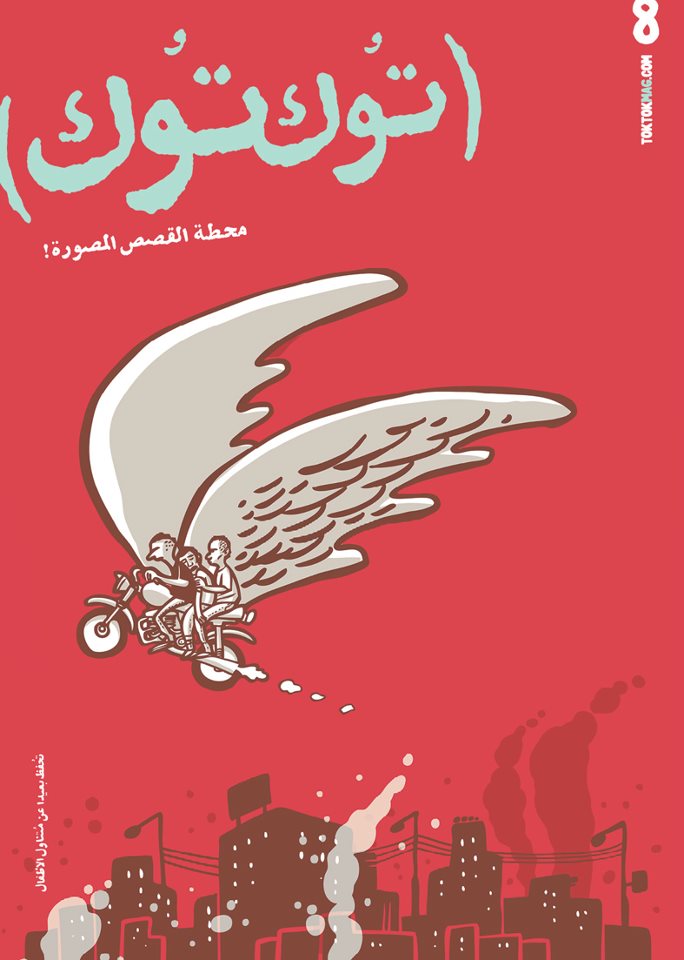
The comic ‘zine Tok Tok, a collaborative publication that has published 13 issues since 2011, similarly engages with the city. The diversity of images from a multitude of artists call on the reader to live deeply in Cairo, to take a deep breath and look around, to sit in an ahwa (café) and drink a tea and talk to people. Tok Tok is also challenges the privileging of satellite cities and rich suburbs. In each issue, multiple narratives take place in downtown Cairo, on recognizable street corners with recognizable characters. The comic is a call to return to the heart of Cairo: a call to engage with its complicated history, to challenge censorship, and as a place for artists to experiment. About a dozen cartoonists, many whom draw for major newspapers, founded the independent publication in the weeks leading up to the 2011 uprising and it has since become a major hit with millennials. Yet Tok Tok’s funding from the European Union and other NGO’s has run out, meaning that the popular ‘zine’s future is uncertain.
Given the stifling of opposition voices in the Egyptian media, art has become the space for dissent. From comics to fine art galleries, and of course graffiti, the realm of the visual is where disempowered critics can attack the powerful. Businessmen also contest authority as they work within and around the confines of the state, which dominates the Egyptian economy. Venture capitalists and artists are both forging innovative paths and bold enterprises while the government sits on its hands. Investing in downtown Cairo during a moment of turbulence signifies experimentation and risk. Showing artworks and installations that defy the regime’s worldview represents another type of audacity. A common thread is that the vibrancy and creativity of Cairenes resists the status quo ante. That a businessman has sought optimistic graffiti for his venture’s façade suggests the ambiguous role of art. The aesthetic realm, it might be said, wields power beyond that of capital.
Tahrir Square has become a parking garage. Art is now the public square.
[1] “Cairo Traffic Congestion Study: Executive Note,” World Bank Group, May 2014. Available at: http://www.worldbank.org/content/dam/Worldbank/TWB-Executive-Note-Eng.pdf
[2] Maggie Fick. “Seeking Unity, Egypt Flies the Flag in Symbolic Tahrir Square,” Reuters, 8 February 2015. Available at: http://uk.reuters.com/article/2015/02/08/uk-egypt-tahrir-idUKKBN0LC0C520150208
[3] Sharif Abdel Kouddous, “Egypt’s 1984,” Cairo Review of Global Affairs, 30 October 2014. Available at: http://www.aucegypt.edu/ gapp/cairoreview/pages/articledetails.aspx?aid=697
[4] I first blogged about this new book on 25 May 2015: http://oumcartoon.tumblr.com/ post/119871802771/mohamed-wahba-elshenawy-cinematic-illustrations-cairo

